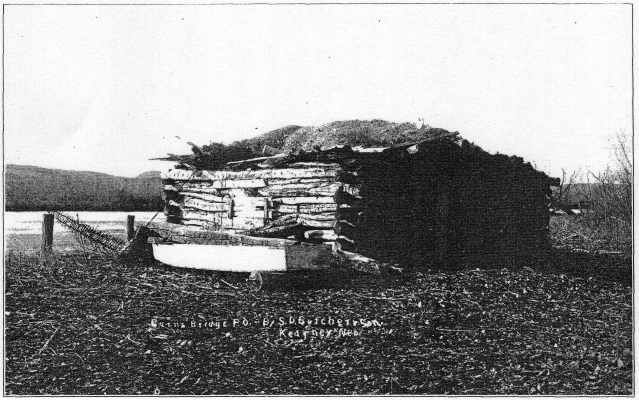
NEGenWeb Project
On-Line Library
NEBRASKA HISTORY MAGAZINE |
273 |
It was near night two days later when I drove into the village. Calling at the store of the place I told the merchant my mission. In answer he related how the fellows had scared the blind preacher off. He advised me, while yet unobserved by thirty or more of the same gang, half-drunk then in a saloon next door, that I had better drive away. In turn I told him that I would drive out to an open space about a block distant and would picket my horses out on the grass and camp until morning at least. I had settled down in my Gospel-wagon when about ten o'clock a man came up and said that the cowboys and half-breeds were going to make a raid on me. I said to him that I had been a soldier of the Civil War and that I had learned to be prepared for any emergency; for him to go and tell them if any person should undertake to come near my wagon during the night I would see that his hide would not hold "shucks". No one dared to venture, but about two o'clock in the morning at a safe distance as they rode away they gave an Indian whoop and fired many shots in the air.
The next day I drove down to the Whetstone Valley, a dozen miles distant and the first persons I met were the ring-leader and two of the gang with him the night before. He told me his name which I had learned in the morning; he was a cattleman. I said to him that I had 'out-bluffed" his outfit last night, then asked him if there was a settler in the valley where he thought a meeting could be held that evening. He gave me the name of Robinson. I told him that I would take the chances of his consenting for the meeting and that I would call it an even deal with him if he would send his herders all about informing everyone settler, cowboy or Indian, of the meeting. He agreed and it was done.
I went to the home, made arrangements for the service to which all came. We sang song after song, everyone taking part. We had an organ accompaniment and organized a Sunday school which proved very beneficial to the settlement in after years.
Returning to Bonesteel the next Sunday I established a school which has never quit up to date.
| 274 | NEBRASKA HISTORY MAGAZINE |
The Cowpath and Doc Middleton's Pony-Boys.
During February, 1885, I was up in Keya Paha County, where Doc. Middleton's notorious outlaw gang of "Pony Boys" held sway. Their rendezvous was at Carns, Nebraska, a crossing of the Niobrara River.
Arriving there in the morning on a very cold day, I went into a little 12'x16' building to warm. Seventeen of the "Pony-Boys" were present, each armed to the teeth with Winchesters and revolvers. They were greatly agitated because three of their number had been captured and hung by the Vigilantes.
While sitting by the fire warming myself, one of the men said, "Elder, what do you think of our business?' I said to him in answer, "Do you consider that your question is a fair one?" He said, "Yes". Then I said, "A fair question is worthy of a fair answer." He answered, "Yes". "Now listen, boys, I will say that my idea and your idea of the business is just the same, that before God and man it is not right; now let me advise you either to quit or to get". I further told them that I did not belong to the "Vigilantes", that I was in the country to help the people to have Sunday schools and to live right before God, our Heavenly Father.
Crossing the Niobrara in Winter.
When I was ready to go they directed me the way to go to Long Pine, there being no road and the town eighteen or twenty miles away. The Niobrara River was to cross, not being entirely frozen over. There was an open channel over which footlogs had been placed. I said to the boys that I wished two or three of them would go and help me across the channel, the logs were covered with frost,
'Doc' Middleton was a frontier character who first achieved fame by running off horses into the Sand Hills. He was assisted by a group of his kind. The Middleton gang had several hiding places in the rugged Niobrara region. Middleton served a term in the state penitentiary, for this kind of horse trailing. When about thirty-five or forty years old he married a young girl. He and his family lived about one block from my printing office at Chadron. Doc then earned an honest living by dealing faro in John Larkin’s saloon. He and his small children were very good friends of mine. Doc wore a "Mormon beard" and had the air of a travelling Methodist preacher. He moved from Chadron to Ardmore, S. D., where he ran a saloon for some years, finally moving to Douglas, Wyoming, where I understand he died about 1914. See further note on p. 351.

Carns Bridge Across Niobrara. Photo about 1900. Butcher Collection in Nebraska State Historical Museum.
274
|
© 2004 for the NEGenWeb Project by Ted & Carole Miller |
||